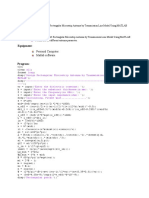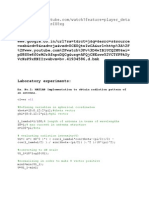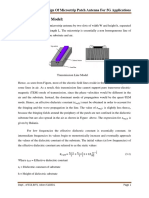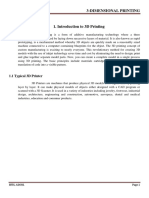MATLAB2
Uploaded by
wasim.MATLAB2
Uploaded by
wasim.clc
clear all
format long
disp(�design rectangular microstrip antenna by transmission line model using
matlab�)
disp(�==========================================================�)
er=input(�enter the dielectric constant:�);
h=input(�enter the substrate thickness (in mm):�);
f=input(�enter the frequency (GHz):�);
z=input(�enter the input impedence(ohm):�);
disp(�calculating. Please wait.�);
f=f*1e9
%calculate the width
Wid=(3e8/(sqrt((er+1)/2)*2*f))*1000; %in mm
%calculate the effective dielectric constant
e_eff=((er+1)/2)+(((er-1)/2)*(1+((12*h)/wid))^-0.5);
%calculate the extension of length L
del_1=(((e_eff+0.3)*((wid/h)+0.264))/((e_eff-0.258)*((wid/h)+0.8)))*(0.412*h);
%in mm
%calculate the effective length
1_eff=(3e8/(2*f*sqrt(e_eff)))*1000;
%calculate the actual length
L=1_eff-(2*del_1);
1a=(3e8/f)*1000;
k=(2*pi)/la;
x+k*(wid);
i1=-2+cos(x)+(x*sinint(x))+(sin(x)/x);
g1=i1/(120*pi*pi); %in
r_in=1/(2*(g1+g12)); %in ohms
inset=(L/pi)*(acos(sqrt(z/r_in))); %in mm
Lg_min+6*h+L; %based on Funit s. Nakar (2004) book
Wg_min=6*h+wid ;
B=60*pi*pi/(z*sqrt(er));
m1=2*2*B-1;
m=log(m1);
n1=B-1;
n=log(n1);
W=(2*h/pi)*(B-1-m+(((er-1)/(2*er))*(n+(0.39*0.61)/er))); %based on Liang J.
(2004) book
g=(3e8*4.65e-9)/(sqrt(2*e_eff)*f*10^-9); %based on journal by M A Matin
(2010)
disp(�RECTANGULAR PATCH�)
disp([�The width of the patch (Wp) is:�,num2str(wid),�mm�])
disp([�The length of the patch (Lp) is:�,num2str(L),�mm�])
disp([�The inset feed patch (Fi) is:�,num2str(inset),�mm�])
disp([�The width of the feed line (wf) is:�,num2str(W),�mm�])
disp([�The gap of the feed line (Gpf) is:�,num2str(g),�mm�])
disp([�The minimum length of ground plane is:�,num2str(Lg_min),�mm�])
disp([�The minimum width of ground plane is:�,num2str(Wg_min),�mm�])
You might also like
- Improving Bandwidth Rectangular Patch Antenna Using Different Thickness of Dielectric SubstrateNo ratings yetImproving Bandwidth Rectangular Patch Antenna Using Different Thickness of Dielectric Substrate6 pages
- Matlab Code For Rectangular Patch AntennaNo ratings yetMatlab Code For Rectangular Patch Antenna2 pages
- Design Engineering: Design A Rectangular Patch Antenna Using Python100% (1)Design Engineering: Design A Rectangular Patch Antenna Using Python10 pages
- Design of New Inset Fed Rectangularسومی Microstrip Patch Antenna with Improved Fundamental ParametersNo ratings yetDesign of New Inset Fed Rectangularسومی Microstrip Patch Antenna with Improved Fundamental Parameters4 pages
- Optimization of An Inset-Fed Calculations For Rectangular Microstrip AntennaNo ratings yetOptimization of An Inset-Fed Calculations For Rectangular Microstrip Antenna6 pages
- Microwave Engineering Pozar Chapter 05 Exercise 09 PDFNo ratings yetMicrowave Engineering Pozar Chapter 05 Exercise 09 PDF11 pages
- Project 2 - Patch Antenna Far-Field Pattern Calculation in MATLAB (May 2015)100% (1)Project 2 - Patch Antenna Far-Field Pattern Calculation in MATLAB (May 2015)17 pages
- Microstrip Rectangular Inset-Fed Patch Array Antenna For WiMax ApplicationNo ratings yetMicrostrip Rectangular Inset-Fed Patch Array Antenna For WiMax Application4 pages
- Rectangular Waveguide TE TM MN Mode E H Field Pattern PlotNo ratings yetRectangular Waveguide TE TM MN Mode E H Field Pattern Plot6 pages
- Modifications To Microstrip-Fed Slot Antenna by FEKONo ratings yetModifications To Microstrip-Fed Slot Antenna by FEKO5 pages
- Analysis and Design of Rectangular Microstrip Patch Antenna AT 2.4Ghz WLAN ApplicationsNo ratings yetAnalysis and Design of Rectangular Microstrip Patch Antenna AT 2.4Ghz WLAN Applications5 pages
- Modifications To Microstrip Fed Slot Antenna by FEKONo ratings yetModifications To Microstrip Fed Slot Antenna by FEKO5 pages
- Design of A 4.5 GHZ Rectangular Microstrip Patch Antenna: Ii. Some Basic Parameters For The Antenna DesignNo ratings yetDesign of A 4.5 GHZ Rectangular Microstrip Patch Antenna: Ii. Some Basic Parameters For The Antenna Design4 pages
- 24_GHz_Microstrip_Patch_Antenna_for_S-Band_WirelesNo ratings yet24_GHz_Microstrip_Patch_Antenna_for_S-Band_Wireles8 pages
- Design of Inset Fed Rectangular Microstrip Patch Antenna For UHF RFID ApplicationNo ratings yetDesign of Inset Fed Rectangular Microstrip Patch Antenna For UHF RFID Application44 pages
- LAB 2 Parametric Optimization of Microstrip Patch Antenna DesignNo ratings yetLAB 2 Parametric Optimization of Microstrip Patch Antenna Design34 pages
- Design and Simulation of Rectangular Patch Antenna: Under The Guidance OF Mr. A.K. Dua (Kiet, Ghaziabad)No ratings yetDesign and Simulation of Rectangular Patch Antenna: Under The Guidance OF Mr. A.K. Dua (Kiet, Ghaziabad)27 pages
- Mircostrip Patch Antenna With E Shaped Structure For S-Band ApplicationsNo ratings yetMircostrip Patch Antenna With E Shaped Structure For S-Band Applications5 pages
- Co Axial Fed Microstrip Rectangular PatcNo ratings yetCo Axial Fed Microstrip Rectangular Patc6 pages
- Performance Indicators of Rectangular Microstrip Patch AntennaNo ratings yetPerformance Indicators of Rectangular Microstrip Patch Antenna12 pages
- Analysis of Rectangular Patch Antenna and Circular Patch Antenna For Bandwidth EnhancementNo ratings yetAnalysis of Rectangular Patch Antenna and Circular Patch Antenna For Bandwidth Enhancement5 pages
- Design and simulation of a Microstrip Patch Antenna (MPA)- Software (CST)-open endedNo ratings yetDesign and simulation of a Microstrip Patch Antenna (MPA)- Software (CST)-open ended9 pages
- Microstrip Antenna Design On Wlan and Dbs Applications: Ritu Lavania, Ashish Duvey, Prasant BadalNo ratings yetMicrostrip Antenna Design On Wlan and Dbs Applications: Ritu Lavania, Ashish Duvey, Prasant Badal3 pages
- Seminar 4 Step by Step Guide To Patch Antenna Design PDFNo ratings yetSeminar 4 Step by Step Guide To Patch Antenna Design PDF5 pages
- Comsol Model Download 198073 Models - Rf.microstrip Patch Antenna Inset100% (1)Comsol Model Download 198073 Models - Rf.microstrip Patch Antenna Inset14 pages
- Shafira Zelinda 'Ainiyatur Rohmah (Saluran Transmisi Antena)No ratings yetShafira Zelinda 'Ainiyatur Rohmah (Saluran Transmisi Antena)17 pages
- Design of Inset Feed Microstrip Patch Antenna For Bluetooth ApplicationNo ratings yetDesign of Inset Feed Microstrip Patch Antenna For Bluetooth Application3 pages
- Analysis of Rectangular and Triangular Microstrip Antenna Arrays Using HFSSNo ratings yetAnalysis of Rectangular and Triangular Microstrip Antenna Arrays Using HFSS7 pages
- A Design Rule For Inset-Fed Rectangular Microstrip Patch Antenna PDFNo ratings yetA Design Rule For Inset-Fed Rectangular Microstrip Patch Antenna PDF10 pages
- Dimensionnement'une Antenne Patch A Frequence FixeNo ratings yetDimensionnement'une Antenne Patch A Frequence Fixe4 pages
- Advanced Chipless RFID: MIMO-Based Imaging at 60 GHz - ML DetectionFrom EverandAdvanced Chipless RFID: MIMO-Based Imaging at 60 GHz - ML DetectionNo ratings yet
- Transmission Line Model:: Design of Microstrip Patch Antenna For 5G ApplicationsNo ratings yetTransmission Line Model:: Design of Microstrip Patch Antenna For 5G Applications9 pages
- Wireless Vision Technology: Dept of ECE, BITS, AdoniNo ratings yetWireless Vision Technology: Dept of ECE, BITS, Adoni19 pages
- Antennas: Design of Microstrip Patch Antenna For 5G ApplicationsNo ratings yetAntennas: Design of Microstrip Patch Antenna For 5G Applications14 pages
- Design of Microstrip Patch Antenna For 5G Applications: Dept., of ECE, BITS, Adoni-518301No ratings yetDesign of Microstrip Patch Antenna For 5G Applications: Dept., of ECE, BITS, Adoni-5183013 pages
- 3-Dimensional Printing: 1.1 Typical 3D PrinterNo ratings yet3-Dimensional Printing: 1.1 Typical 3D Printer16 pages




































































